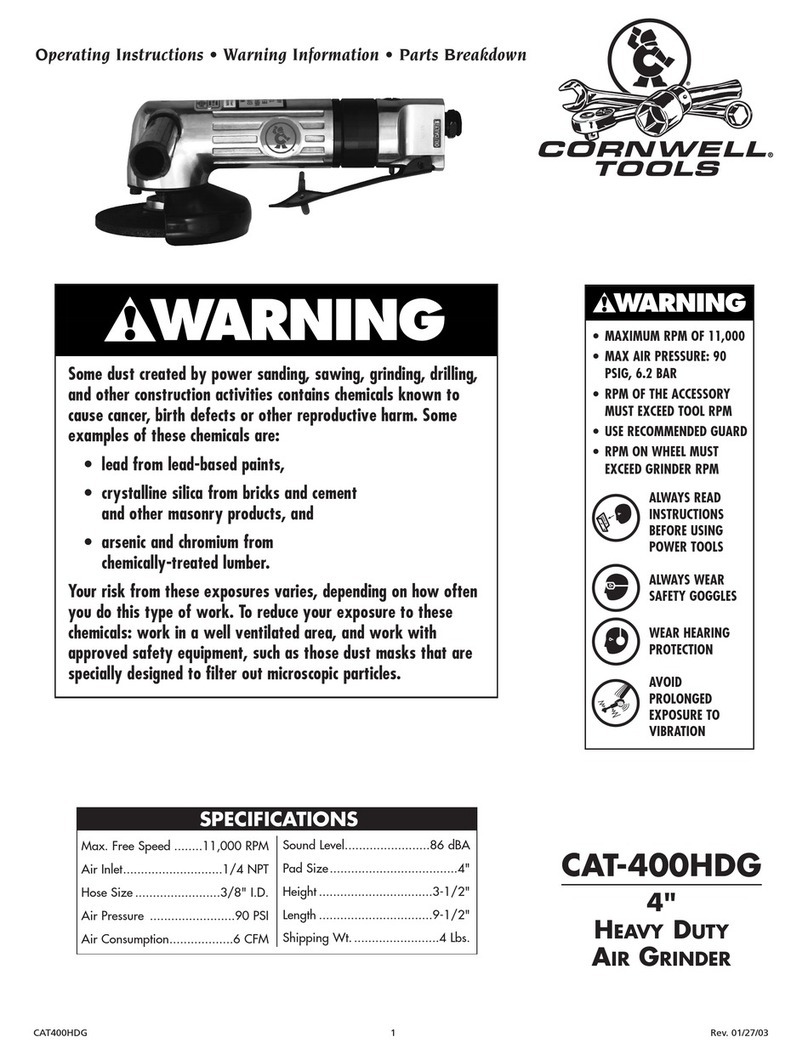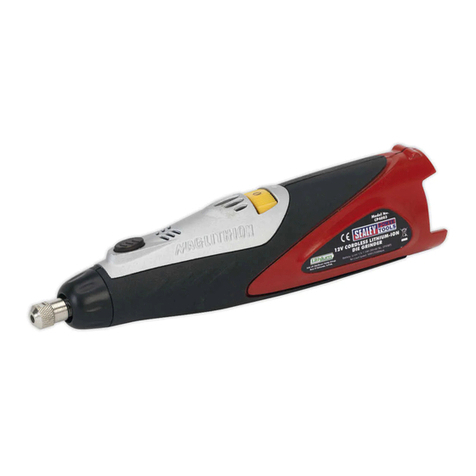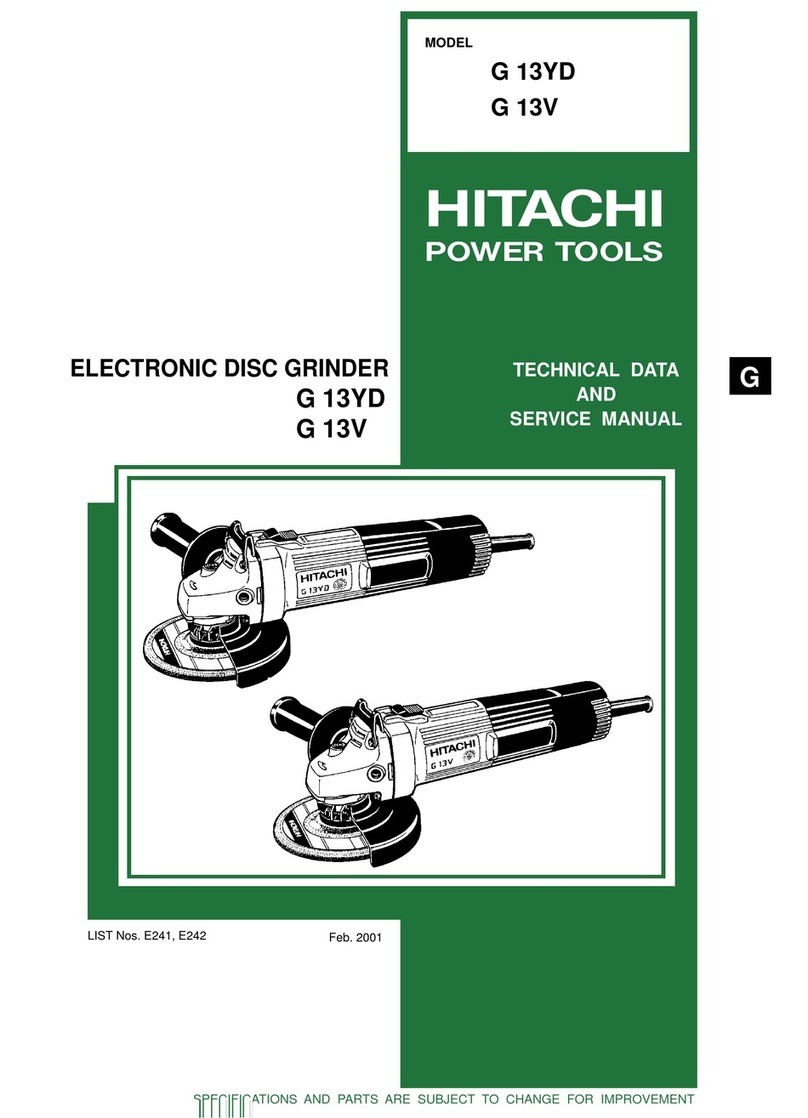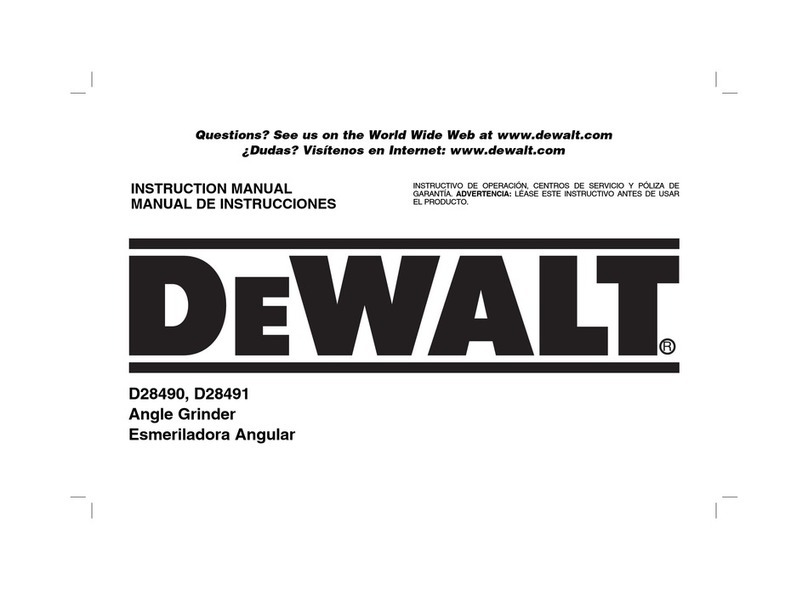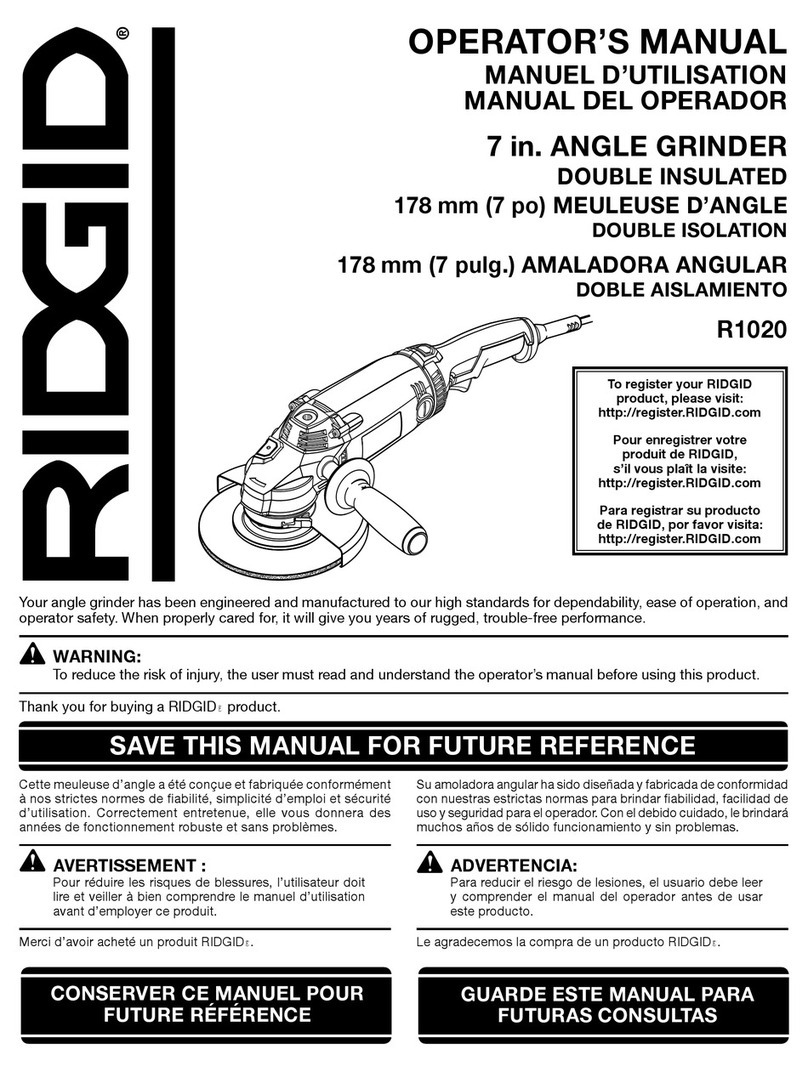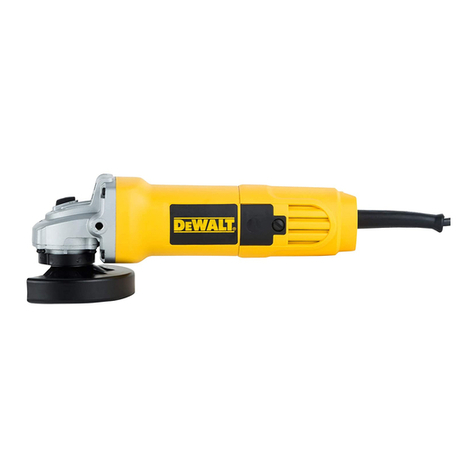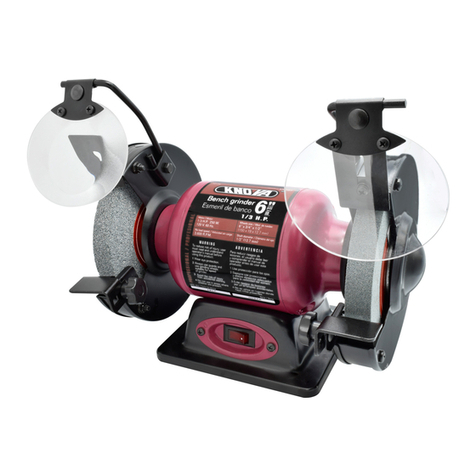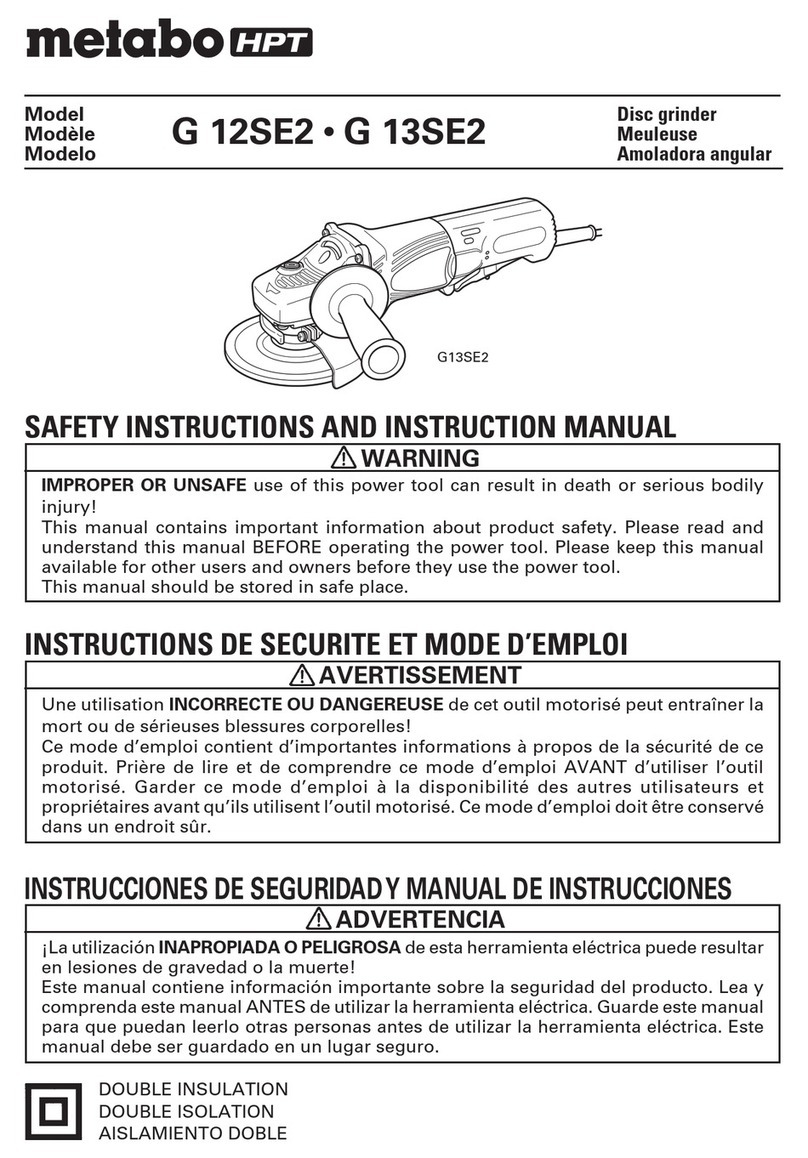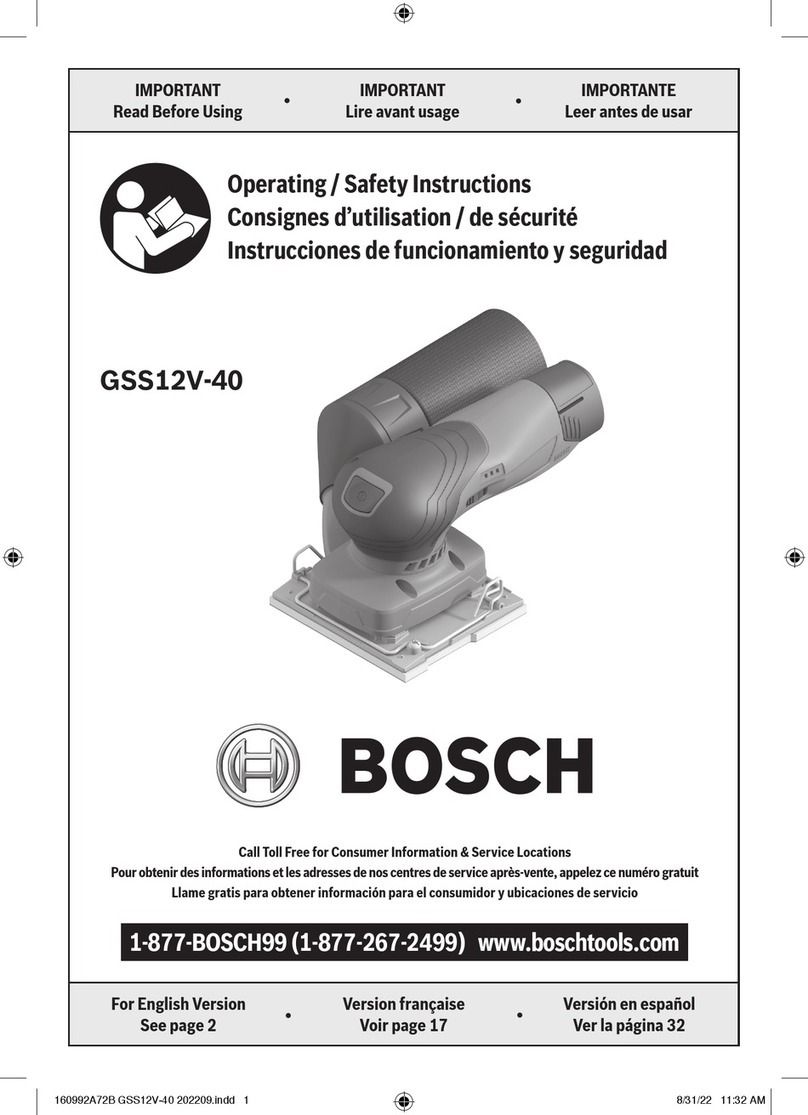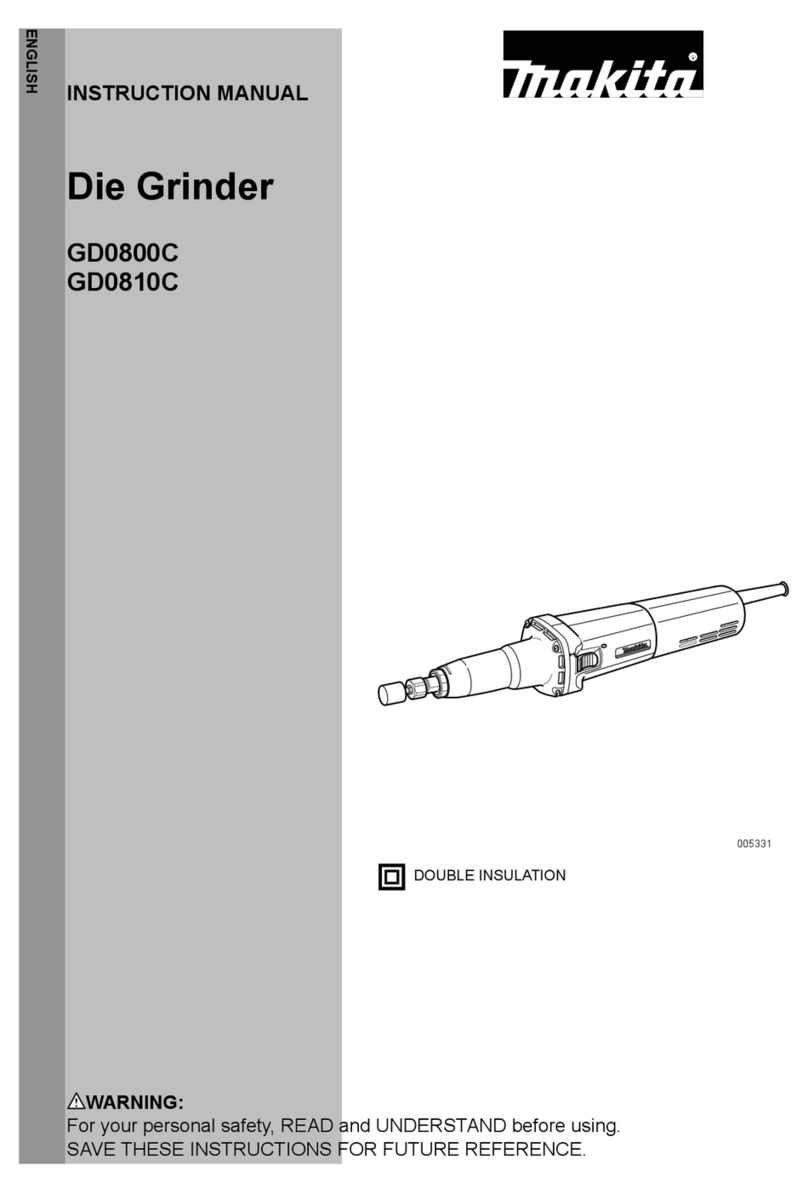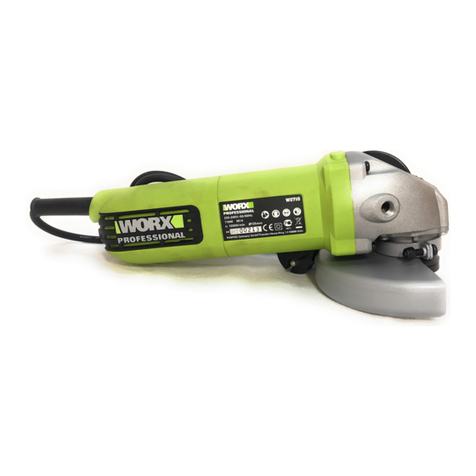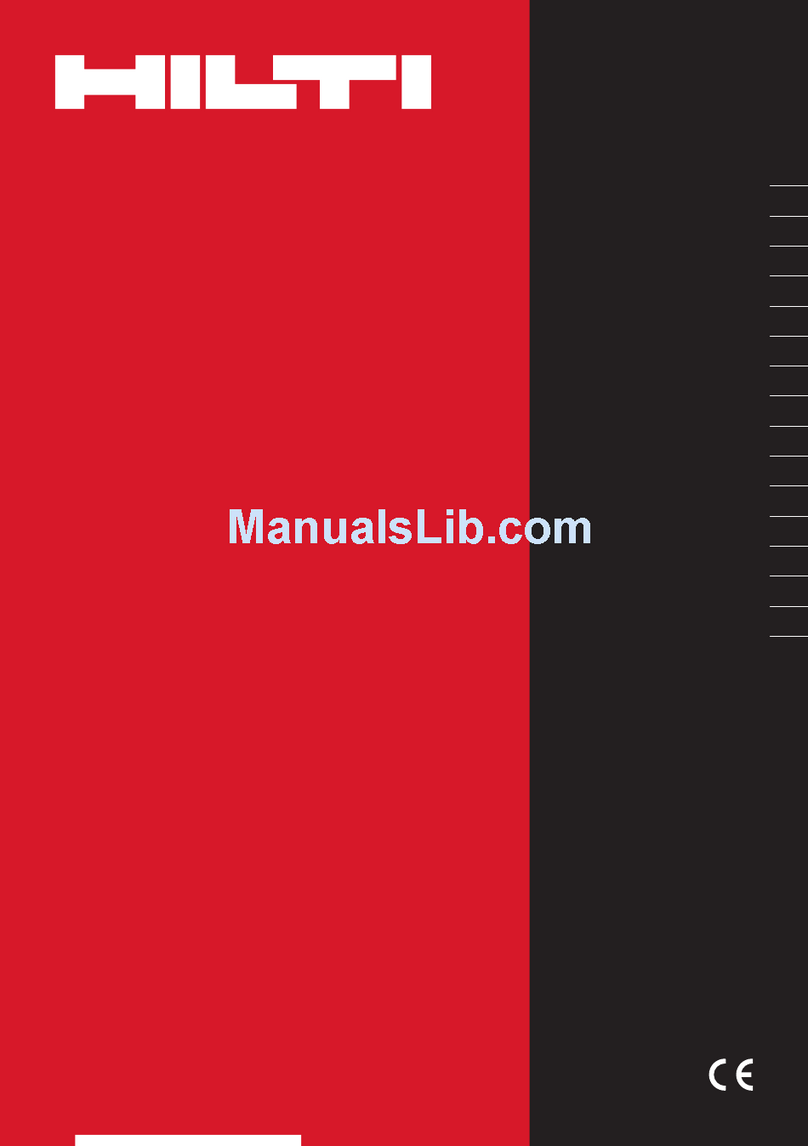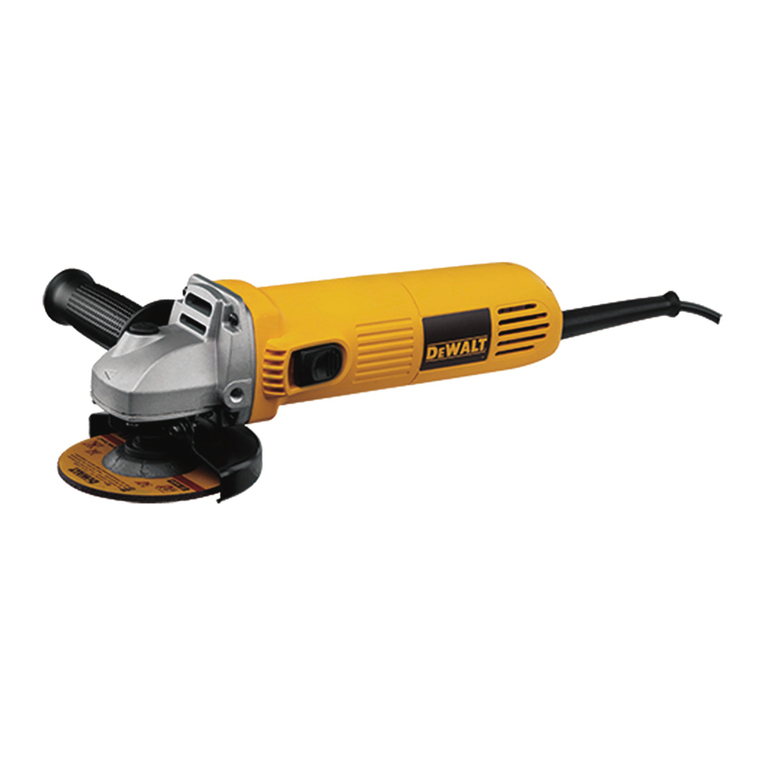Provisur Weiler 6 Setup guide

Model 6 Grinder
AAM−136 Revised June 5, 2012 1
Next Generation of Grinding Technology
Grinding

AAM−136 Revised June 5, 2012 2
TABLE OF CONTENTS
GENERAL SAFETY
INFORMATION 3.................
SAFETY LABEL PLACEMENT 5...
INTRODUCTION 6................
GENERAL DESCRIPTION 6...................................
GRINDER APPLICATIONS 6..................................
INSTALLATION INSTRUCTIONS 7.
CORRESPONDENCE 7.......................................
SHIPPING INFORMATION 7...................................
UNPACKING / UNCRATING 7.................................
LIFT EQUIPMENT & LIFTING REQUIREMENTS 7................
PRE−INSTALLATION CHECKS 7...............................
LOCATION (Fig. 4 ) 7.........................................
ANCHORING 7.............................................
DRAINAGE SLOPE (Fig. 5 ) 8..................................
ELECTRICAL 8.............................................
DIRECTION OF ROTATION (Fig. 6 ) 8...........................
DISASSEMBLY INSTRUCTIONS 9..
REQUIRED TOOLS (Fig. 7 ) 9..................................
STEP 1: REMOVE ORIFICE PLATE GUARD (Fig. 8 ) 9.............
STEP 2: REMOVE RING (Fig. 9 ) 9.............................
STEP 3: REMOVE PLATE (Fig. 10 ) 9...........................
STEP 4: REMOVE KNIFEHOLDER (Fig. 11 ) 10....................
STEP 5: REMOVE CENTERING PIN (Fig. 12 ) 10...................
STEP 6: REMOVE SPRING (Fig. 13 ) 10..........................
STEP 7: REMOVE FEED SCREW 10.............................
STEP 8: FEED SCREW SUPPORT CART (Fig. 14 ) 10................
CLEANING INSTRUCTIONS 11.....
ASSEMBLY INSTRUCTIONS 13.....
STEP 1: INSTALL FEED SCREW/ 13.............................
STEP 2: CHECK FEED SCREW HEAD SPACE (Fig. 16 ) 13...........
STEP 3: ADJUST FEED SCREW HEAD SPACE (Fig. 17 ) 13..........
STEP 4: INSTALL EXCLUDER SEAL AND INSTALL FEED SCREW
(Fig. 18 ) 13..................................................
STEP 5: INSTALL KNIFE TENSION SPRING (Fig. 19 ) 14............
STEP 6: INSTALL CENTERING PIN (Fig. 20 ) 14...................
STEP 7: INSTALL KNIFEHOLDER (Fig. 21 ) 14....................
STEP 8: INSTALL PLATE AND (OPTIONAL BCA ONLY) BUSHING
(Fig. 22 ) 15..................................................
STEP 9: (Optional) INSTALLATION OF TEARDROP HOLE PLATES
(Fig. 23 ) 15..................................................
STEP 10: INSTALL GRINDER RING (Fig. 24 ) 15...................
STEP 11: INSTALL ORIFICE PLATE GUARD (Fig. 25 ) 16...........
OPERATING INSTRUCTIONS 17....
HOPPER COVER SAFETY INTERLOCK SWITCH
(OPTIONAL) (Fig. 26 ) 17......................................
HOPPER GUARD (Fig. 27 ) 17..................................
PRE−OPERATION CHECKS 17..................................
RECOMMENDED FEEDING METHODS. 17.......................
CONVEYOR FEEDING (Fig. 28 ) 18..............................
COLUMN DUMPER FEEDING (Fig. 29 ) 18........................
MANUAL FEEDING (Fig. 30 ) 18................................
KEEP FEED SCREW COVERED (Fig. 30 ) 18......................
KEEP HANDS AND FINGERS AWAY (Fig. 31 ) 19..................
EMERGENCY STOPPING (Fig. 32 ) 19............................
NORMAL SHUT−DOWN 19....................................
INSPECTION & MAINTENANCE 20.
MAINTENANCE SCHEDULING 20..............................
INSPECTION/MAINTENANCE SCHEDULE 20....................
DRIVE BELT PULLEY ALIGNMENT 20..........................
BELT TENSION 20............................................
UNDERMOUNT FRAMES (Fig. 36 ) 21...........................
MOTOR 21..................................................
LUBRICATION INSTRUCTIONS 22..
GEARBOX OUTER SEAL (Fig. 37 ) 22............................
LUBRICATION CHART 23..........
TROUBLESHOOTING GUIDE 25....
REPAIR / REBUILD OF PARTS 28....
PLATE RETAINING RING (Fig. 38 ) 28...........................
ORIFICE PLATES (Fig. 39 , 40 , 41 ) 28............................
KNIFE INSERT REMOVAL (Fig. 42 ) 29...........................
KNIFE INSERT INSTALLATION (Fig. 43 ) 29......................
CENTERING PIN AND BUSHING (Fig. 44 ) 29.....................
KNIFE TENSION SPRING (Fig. 45 ) 29...........................
BASIC HEAD REPAIR/REBUILD (Fig. 46 ) 30......................
FEED SCREW REPAIR (Fig. 47 ) 31..............................
CHECKING FOR FLATNESS (Fig. 48 ) 31.........................
WARRANTY 32.....................

AAM−136 Revised June 5, 2012 3
GENERAL SAFETY INFORMATION
WARNING
Turn off and lock out machine power source(s) following the lockout / tagout procedures
described in OSHA CFR 29 1910.147 Code of Federal Regulations (or equivalent).
Where references to shutting off and locking out power are made in this manual, unless
indicated otherwise, make sure that the power to all systems, whether electrical, hydraulic
or other, is off and locked out with a padlock.
If your unit is part of a system powered by a central electric or hydraulic power station, the
lock−out must be located in the grinder power circuit.
1. Do not, under any circumstances or for any
reason, place hands, feet or any part of your
body inside the hopper when the unit is
operating.
2. If it does become necessary to perform service,
be absolutely certain that:
a. Power to all motors is off and locked out and
b. Main circuit breakers are off and/or fuses (if
used) are removed from the main power
source.
c. All electrical power cables have been
disconnected from all motors or
d. All drive belts or chains have been removed
from all drive systems.
3. This unit may be equipped with a locking chain
safety device that is attached to the trolley
wheel bolts on the FP1000 Feed Screw Lift /
Puller. This device MUST BE USED to prevent
the feed screw from being pulled off the lifting
pin while removing and installing the feed
screw.
4. Do not install any walkways or service
platforms which would allow any persons to
reach dangerous “nip” points while the machine
is operating.
5. Remove foreign objects or product from the
hopper with long-handled tools. Use long
handled brushes or mops if brushing or wiping
is necessary.
6. If foreign objects (metal hooks, shovels, forks,
knives, boxes, paper, etc.) accidentally fall into
the hopper, do not attempt retrieval while the
unit is in operation. Shut off and lock out the
power first.
7. Even though power is disconnected, make sure
no one is working inside a “non-operative”
grinder while removing or installing drive belts
or chains, or when servicing any part of the
drive system.
8. The feed screw may rotate for 15 seconds or
longer after power is shut off. Before
performing service, let the rotating parts come
to a complete halt, disconnect and lock out the
power with a padlock.
9. Keep hands and tools away from all product
outlet and inlet areas until machine has
completely stopped and power is locked out
with a padlock.
10. Some parts requiring service are heavy. Wear
gloves and safety-toed shoes when servicing.
Wear protective goggles to protect the eyes
when cleaning.
11. All safety guards, including drive system
guards, must be put back in place before
operating. Replace safety stickers if they
become loose, lost, fragmented, discolored or
faded.
12. When this machine is running, the decibel
reading may exceed 85 db.
13. NO work is to be performed on this machine
without the operators knowledge.
14. Do not use this machine for purposes other
than the original intended use.

AAM−136 Revised June 5, 2012 4
GENERAL SAFETY INFORMATION
DANGEROUS “NIP” AREAS. Getting hands caught in these areas will cause serious injury
and could pull you into the feed hopper.
DO NOT REACH BEYOND THE TOP OF THE HOPPER WHEN GRINDER IS
OPERATING. READ ALL GENERAL SAFETY INFORMATION ON PAGE 3 OF THIS
MANUAL BEFORE OPERATING, SERVICING OR CLEANING THE GRINDER.
DO NOT PUT FINGERS INTO
CUTTING PLATE HOLES. THE
CUTTING KNIFE IS LOCATED
DIRECTLY BEHIND THE
ORIFICE PLATE AND COULD
CAUSE SERIOUS INJURY.
Fig. 1 Typical Model 6 Grinder.
DEFINITIONS OF HAZARD LEVELS USED ON SAFETY LABELS:
Immediate hazard which WILL result in severe
personal injury or death.
Hazards or unsafe practices which COULD result in
severe personal injury or death.
Procedures or practices which WILL or COULD
result in damage to equipment and/or destruction
to equipment or product.

AAM−136 Revised June 5, 2012 5
SAFETY LABEL PLACEMENT
(Label 4) 018−0611 (Moving Parts
Can Crush Label)
(Label 2) 018−1010 (Gearbox Tag)
NOTE: Approximate locations are shown. Do not
place labels closer than 3” to any corner edge or joint.
(Label 1) 018−1011 (Weiler Serial Number Tag)
(and opposite side)
(and opposite side)
(and opposite side)
(and opposite side)
NOTE: Right Hand Side Mount
frame shown. For Left Hand
Side Mount frames, label
placement should be in
the same general
location.
(Label 3) 018−3505 (Read and
Understand Manual...)
(Label 5) 018−0612 (Rotating
Parts Inside)
Required Number
Label 1 1 each...........
Label 2 1 each...........
Label 3 3 each...........
Label 4 2 each...........
Label 5 2 each...........
REAR VIEW FRONT VIEW
Fig. 2 Placement of Safety Labels.

AAM−136 Revised June 5, 2012 6
INTRODUCTION
FEED HOPPER
MOTOR GUARD
HOPPER GUARD
FLUTED HEAD
ORIFICE PLATE
GUARD
FRAME
GEARBOX
Fig. 3 Typical Model 6 Grinder on an Undermount Frame.
GENERAL DESCRIPTION
The basic Weilerrgrinder consists of a feed screw
supported inside a feed hopper/head assembly. The
feed hopper/head assembly is supported on a single
reduction gearbox. The feed screw is driven by the
main shaft of the gearbox and transports the
product through a fluted head and through sizing
holes in a plate.
GRINDER APPLICATIONS
Each Weilerrgrinder is designed to grind a
specific product or products. If the grinder will be
used for work other than originally intended,
contact the factory immediately for information
and recommendations.

AAM−136 Revised June 5, 2012 7
INSTALLATION INSTRUCTIONS
CORRESPONDENCE
All Weilerrequipment is identified by serial
numbers and model numbers.
SHIPPING INFORMATION
Grinders are usually shipped on skids or
completely crated. Any accessories are either
banded to, or placed inside the unit.
UNPACKING / UNCRATING
A common set of S.A.E. wrenches and/or carpenter
tools may be required to remove skids or crating
materials.
Remove all wrapping material and parts that might
be inside hopper or banded to the grinder.
LIFT EQUIPMENT & LIFTING
REQUIREMENTS
WARNING
Use a crane or forklift that is rated to lift
and move your unit.
NOTE: The center of gravity may differ with each
grinder, depending upon type of frame, motor or
other grinder components. If necessary, a qualified
material handler/mover should be contacted to
provide information about lifting points.
WARNING
Do not lift the unit any higher than
necessary for movement across floor
surfaces. Move carefully and slowly.
PRE−INSTALLATION CHECKS
EXTERIOR CHECK: Use the packing slip
accompanying your unit to verify that the shipment
is complete and correct. Check the following.
a. Model/Serial Number (On I.D. Tag
located on frame and feed hopper).
b. Spare Parts should be accounted for (See
Spare Parts).
c. All exposed fasteners should be tight and
accounted for.
INTERIOR CHECK: Check the following:
a. Are motor and gearbox pulleys aligned
and tight?
b. Remove guard cover and check drive
belt/chain alignment and tension.
c. Check oil level in gearboxes (Refer to
Lubrication Instructions in the Gearbox
Service Instructions).
d. General condition of parts.
LOCATION (Fig. 4 )
Check for ample space around the machine to
perform service.
1. Front end to remove feed screw.
2. Rear end and sides to remove guard
covers.
3. Associated equipment matches unit output
and height (load and unload).
Allow for work space around the grinder for safe
movement, operation and certain maintenance
functions.
NOTE: Additional space may be required in front
of unit if a FP1000 Feed Screw Lift/Puller is used
to remove and install feed screw.
72”
(1829mm)
*Low Frame
63−1/8”
(1603mm)
or
55−1/8”*
(1400mm)
48”
(1219mm)
36”
(914mm)
48”
(1219mm)
50−5/8”
(1286mm)
or
42−5/8”*
(1083mm)
33−13/16”
(859mm)
or
25−13/16”*
(656mm)
Fig. 4 Work Space Required.
ANCHORING
WARNING
Failure to secure unit to floor can cause
movement, tipping or torque bending of
unit. This can be hazardous to
operators and/or equipment.
Use holes in foot pads to locate floor anchor
positions. All Weilerrequipment must be securely
anchored to the floor before wiring and operating
can begin.

AAM−136 Revised June 5, 2012 8
DRAINAGE SLOPE (Fig. 5 )
Install the grinder so that the product outlet end
slopes downward approximately 1. This will
allow for water drainage during clean−up. It may
be necessary to place shims or spacers under foot
pads. Maintain slope but level from side to side.
1
SHIM
Fig. 5 Drainage Slope.
ELECTRICAL
WARNING
Turn off and lock out machine power
source(s) following the lockout / tagout
procedures described in OSHA CFR 29
1910.147 Code of Federal Regulations
(or equivalent).
Consult local electrical codes and review all
applicable Standards, prior to placing and installing
wiring and controls. Employ a qualified registered
electrician or contractor for final wiring. Standards
found in CHAPTER XVII, SECTION 1910.309
(OSHA) NATIONAL ELECTRICAL CODE
NFPA 70−1971; ANSI C1−1971 (Rev. of
C1−1986) (or equivalent) shall apply to all
electrical installations and utilization equipment.
WARNING
To prevent hazardous situations for
each machine:
1. Do NOT use dual controls (more
than one ON−OFF switch) for the
same motor.
2. Do NOT use dual circuits (more
than one power source to the same
motor).
3. Do NOT use the grinder starter
controls to supply power for any
other machines.
4. The operators control station shall
not be mounted in hard to reach,
remote or hidden areas. It must be
visible and convenient for any
emergency that requires immediate
shut−off of the machines.
5. If your unit is part of a system
powered by a central hydraulic
power station, the lock−out must
be located in the grinder power
circuit.
DIRECTION OF ROTATION (Fig. 6 )
During normal operation the feed screw should
rotate counterclockwise (viewed from front of
unit).
WARNING
Immediately following rotation check,
shut off main power and lock it out with
a padlock.
FEED SCREW ROTATES
COUNTER−CLOCKWISE (viewed from front).
Fig. 6 Direction of Rotation During Normal Operation.

AAM−136 Revised June 5, 2012 9
DISASSEMBLY INSTRUCTIONS
RING WRENCH /
WORM INSERTION TOOL
PLATE LIFTER
KNIFE INSERT
REMOVAL TOOL
Fig. 7 Special Tools.
WARNING
Turn off and lock out machine power
source(s) following the lockout / tagout
procedures described in OSHA CFR 29
1910.147 Code of Federal Regulations
(or equivalent).
REQUIRED TOOLS (Fig. 7 )
RING WRENCH / WORM INSERTION
TOOL: Fits over lugs of ring and is used to turn
ring off counterclockwise (CCW) and on clockwise
(CW). Also used to assist in engaging the feed
screw onto the gearbox spline.
PLATE LIFTER: Lifts end of feed screw to
center the plate in head opening. Used to remove
and install plate/bushing assembly. Also used to
remove tension spring from feed screw pin hole.
KNIFE INSERT REMOVAL TOOL: Use this
tool to remove inserts when they become worn
down. Refer to Page 29.
STEP 1: REMOVE ORIFICE PLATE GUARD
(Fig. 8 )
Loosen thumb screws and remove orifice plate
guard. Set aside for cleaning later.
ORIFICE PLATE GUARD
Fig. 8 Remove Orifice Plate Guard.
STEP 2: REMOVE RING (Fig. 9 )
RING
RING WRENCH TURN RING
COUNTER−CLOCKWISE
TO LOOSEN
Fig. 9 Ring Removal.
STEP 3: REMOVE PLATE (Fig. 10 )
Remove plate and bushing (if applicable) by
putting plate lifter “point” on first thread at end of
head. Place loop around centering pin. Lift up and
down while pulling back on plate.

AAM−136 Revised June 5, 2012 10
PLATE LIFTER
POINT
PLATE
LOOP
Fig. 10 Plate and Removal.
STEP 4: REMOVE KNIFEHOLDER (Fig. 11 )
KNIFEHOLDER
Fig. 11 Knifeholder Removal.
STEP 5: REMOVE CENTERING PIN
(Fig. 12 )
CENTERING PIN
Fig. 12 Centering Pin Removal.
STEP 6: REMOVE SPRING (Fig. 13 )
SPRING
Fig. 13 Spring Removal.
STEP 7: REMOVE FEED SCREW
WARNING
Use caution when handling. Feed
Screws can weigh 100 lbs. (45 KG) or
more.
STEP 8: FEED SCREW SUPPORT CART
(Fig. 14 )
After feed screw is removed from grinder, place it
on a stable support for cleaning. Remove excluder
seal from drive end.
EXCLUDER SEAL FEED
SCREW
SUPPORT
CART
Fig. 14 Typical Feed Screw Support Cart.

AAM−136 Revised June 5, 2012 11
CLEANING INSTRUCTIONS
WARNING
Turn off and lock out machine power
source(s) following the lockout / tagout
procedures described in OSHA CFR 29
1910.147 Code of Federal Regulations
(or equivalent).
1. SAFETY DURING CLEANING:
Safety and product data sheets of the
cleaning and disinfection agents* must be
observed. (*Adhere to chemical
manufacturers instructions at all times).
Wear suitable gloves, safety shoes and
eye protection to prevent injury from sharp
parts, falling objects and flying debris
which may be caused by water spray.
Be extremely careful when handling steam
and hot, high velocity water hoses to
prevent burns or other injury to body and
eyes.
Do not directly flush any operating stations
and/or electrical panels with steam and/or
high−pressure cleaning solutions. This
will cause excessive condensation inside
the enclosures which could cause failure.
Water could also be forced past enclosure
door seals which could cause failure.
Do not direct live steam and/or high
pressure water directly towards the input
or output splines of any reducers. Water
may be forced past the seals and into the
reducer cavity which could eventually
cause failure.
Do not stand on adjacent equipment,
boxes, ladders, tables, etc. Always use
proper platforms during cleaning.
USE CARE IN HANDLING CLEANED,
OILED PARTS AS THEY WILL BE
SLIPPERY.
2. EDUCATION AND INSTRUCTION OF
CLEANING STAFF:
Always make sure that the machine is
cleaned by a qualified and well−instructed
staff which has read and understood this
chapter.
3. FREQUENCY:
The machine is to be cleaned daily
according to demand and to existing
requirements of the authorities.
4. PROCEDURE:
a. Thoroughly pre−flush the overall unit
with steam and/or high−pressure
water of at least 122−140F
(50−60C).
b. Disassemble the unit according to the
Disassembly Instructions found on
Page 9. Any tools required to
disassemble for cleaning should be
cleaned themselves prior to their use.
c. Utilize a mild detergent* to clean all
stationary parts on the machine.
Apply a foam cleaning solution* with a
brush to the entire machine. If
necessary, use a long−handled brush
on the areas inside the hopper. Do
not enter the hopper. Allow the
solution to work approximately 20
minutes.
(*Adhere to chemical manufacturers
instructions at all times).
d. Flush with clean water.
e. Carefully inspect whether the
machine is clean −especially on
critical places such as edges, etc.
f. Sanitize the machine with a
disinfecting solution*. Allow this
solution to work approximately 30−60
minutes.
(*Adhere to chemical manufacturers
instructions at all times).
g. Re−flush the machine carefully with
clean water before taking the
machine into operation.
5. DRY PARTS:
Dry all parts thoroughly after cleaning.
Spare parts should be well oiled with
U.S.D.A. approved (or equivalent) and
kept in a clean, dry place.
6. SAFETY LABELS:
Check all safety labels for legibility after
each clean−up procedure. Replace as
necessary.

AAM−136 Revised June 5, 2012 12
REMOVE CLIPS FROM HOPPER ROD END.
RAISE HOPPER GUARD AND THOROUGHLY
CLEAN INSIDE AND OUTSIDE OF UNIT AS
DESCRIBED ABOVE. FRAME SIDE PANELS
SHOULD BE REMOVED PERIODICALLY
(WEEKLY) FOR CLEANING AS NECESSARY
REMOVE PLATE
GUARD AND
CUTTING PARTS
AS DESCRIBED IN
DISASSEMBLY
INSTRUCTIONS.
THOROUGHLY
CLEAN INSIDE AND
OUTSIDE OF UNIT.
*Adhere to chemical manufacturers instructions at all times.
Fig. 15 Typical Model 6 Grinder.

AAM−136 Revised June 5, 2012 13
ASSEMBLY INSTRUCTIONS
WARNING
Turn off and lock out machine power
source(s) following the lockout / tagout
procedures described in OSHA CFR 29
1910.147 Code of Federal Regulations
(or equivalent).
STEP 1: INSTALL FEED SCREW/
WARNING
Use caution when handling. Feed
Screws can weigh 100 lbs. (45 KG) or
more.
STEP 2: CHECK FEED SCREW HEAD
SPACE (Fig. 16 )
The relationship of the feed screw to the head is
critical to proper grinding. The feed screw must be
installed without excluder seal, then, a
measurement taken between the face of the feed
screw and the end of the head. This dimension
MUST BE 5/8” (15.8mm).
5/8”
FEED−
SCREW
FACE
END OF
HEAD
HEAD PRESSURE
FLIGHT
ÉÉÉ
ÉÉÉ
ÉÉÉ
ÉÉÉ
ÉÉÉÉÉ
ÉÉÉÉÉ
ÇÇÇÇÇÇ
ÇÇÇÇÇÇ
ÇÇÇÇÇÇ
ÇÇÇÇÇÇ
(15.8mm)
Fig. 16 Check Feed Screw Head Space.
STEP 3: ADJUST FEED SCREW HEAD
SPACE (Fig. 17 )
Make certain that the thrust screw (or cap screw on
the back of the feed screw (or on the gearbox
mainshaft) is securely tightened and is in good
condition. Adding a washer will decrease the feed
screw head space. Removing a washer will
increase that dimension.
ÉÉÉÉÉÉÉ
ÉÉÉÉÉÉÉ
ÉÉÉÉÉÉÉ
ÉÉÉÉÉÉÉ
ÉÉÉÉÉÉÉ
ÉÉÉÉÉÉÉ
ÉÉÉÉÉÉÉ
GEARBOX
MAIN SHAFT
SPLINE
SPACER
WASHER
THRUST
SCREW
EXCLUDER SEAL
Fig. 17 Adjust Feed Screw Head Space.
STEP 4: INSTALL EXCLUDER SEAL AND
INSTALL FEED SCREW (Fig. 18 )
Install excluder seal on drive end of feed screw.
The “lip” of the seal must face toward the spline
end. Lubricate seal and drive spline of feed screw
with U.S.D.A. approved (or equivalent) grease.
Install feed screw (See STEP 1).

AAM−136 Revised June 5, 2012 14
EXCLUDER SEAL LIP
FEED SCREW DRIVE
SPLINE END
EXCLUDER
SEAL
Fig. 18 Install Excluder Seal and Install Feed Screw.
STEP 5: INSTALL KNIFE TENSION SPRING
(Fig. 19 )
Insert spring into feed screw hole with beveled end
first.
SPRING
BEVELED END
GOES IN FIRST
Fig. 19 Install Knife Tension Spring.
STEP 6: INSTALL CENTERING PIN
(Fig. 20 )
Lubricate pin with a small amount of U.S.D.A.
approved (or equivalent) grease or mineral oil and
insert over spring.
NOTE: Pin shoulder should project 3/16” from
feed screw recess.
CENTERING PIN
Fig. 20 Install Centering Pin.
STEP 7: INSTALL KNIFEHOLDER (Fig. 21 )
Install knifeholder. If two blade knifeholder is
used, line up the blades with pressure flights.
Failure to install two blade knifeholders as
described may result in damage. Three and four
blade knifeholders can be installed only one way.
KNIFEHOLDER
Fig. 21 Install Knifeholder.

AAM−136 Revised June 5, 2012 15
STEP 8: INSTALL PLATE AND (OPTIONAL
BCA ONLY) BUSHING (Fig. 22 )
Lubricate cutting side of plate with U.S.D.A.
approved (or equivalent) grease. Use plate lifter
tool as shown, and install plate into grinder head.
FOR BCA ONLY: Lubricate inside bore of
bushing with U.S.D.A. approved (or equivalent)
grease. Install bushing into plate and then install
both into grinder head using plate lifter tool.
PLATE LIFTER
POINT
PLATE
LOOP
Fig. 22 Install Plate and (Optional) Bushing.
STEP 9: (Optional) INSTALLATION OF
TEARDROP HOLE PLATES (Fig. 23 )
Install plates with irregular shaped holes as shown
below. This way the knife will move the product
toward the center of the plate.
CAUTION: TIGHTEN PLATE RETAINING
RING “HAND TIGHT ONLY”. DO NOT USE
RING WRENCH TO TIGHTEN AS DAMAGE
TO PLATE MAY RESULT.
CORRECT INCORRECT
Fig. 23 Installation of Teardrop Hole Plates.
STEP 10: INSTALL GRINDER RING
(Fig. 24 )
CAUTION: All threads must be cleaned and
lubricated with U.S.D.A. (or equivalent) approved
grease or mineral oil before installing ring onto
grinder head. Dirty threads will cause incorrect
plate/knifeholder spring tension and will result in
poor cutting action.
Place ring onto head. Hold pressure against the
ring as you turn CLOCKWISE. If threading does
not occur, reverse direction, still holding pressure
until the ring “jumps” a thread. Then thread on
clockwise, all the way.
Using the ring wrench or ratchet lever, turn the ring
on as far as it will go without forcing then unscrew
counterclockwise 1/8 turn.This will shift the
plate notch up against the supporting side of the
plate lug in the head, which will prevent premature
wear of the plate lug.
NOTE: The only exception to this tightening
method is when using a teardrop or round hole
plate with holes larger than 1” (25mm) diameter.
Then snug the ring onto the head HAND TIGHT
ONLY.
DO NOT FORCE THE RING ON. IF BINDING
OCCURS, REMOVE THE RING AND CHECK
THREADS AND LUGS.
DO NOT OVER−TIGHTEN THE RING BY
USING A BAR OR HAMMER ON THE
WRENCH OR RING LUGS.
DO NOT USE A BAR BETWEEN BRIDGE
SUPPORTS OF RING, IN LIEU OF RING
WRENCH.

AAM−136 Revised June 5, 2012 16
TURN RING CLOCKWISE
TO TIGHTEN
RING WRENCH
Fig. 24 Install Grinder Ring.
STEP 11: INSTALL ORIFICE PLATE
GUARD (Fig. 25 )
Install orifice plate guard onto grinder by sliding
both shafts into clamps. Tighten thumb screws to
secure plate guard in place.
ORIFICE PLATE GUARD
Fig. 25 Install Orifice Plate Guard.

AAM−136 Revised June 5, 2012 17
OPERATING INSTRUCTIONS
WARNING
Do not operate this unit until you have
read and understand all of the general
safety information on page 3, and the
operating and maintenance
instructions.
If your unit is part of a system powered
by a central hydraulic power station, the
lock−out must be located in the grinder
power circuit.
Do not leave the grinder unattended
while it is running.
Do not permit unauthorized persons
near the grinder.
HOPPER COVER SAFETY INTERLOCK
SWITCH (OPTIONAL) (Fig. 26 )
Your unit may be equipped with a hopper cover
with a safety interlock switch. If so, the cover
must be closed to complete the electric circuit
before any operation can begin. Refer to General
Safety Information on Page 3.
HOPPER COVER
SAFETY
INTERLOCK
SWITCH
Fig. 26 Hopper Cover Safety Switch.
HOPPER GUARD (Fig. 27 )
If your unit is not equipped with a hopper cover,
then it may have a hopper guard with rods. To
remove the hopper guard (during cleaning or
maintenance) you must remove the hair pin clips
from the ends of the rod and slide the rod out.
Tilt the hopper guard up to allow access to the
inside of the hopper for cleanup.
HOPPER GUARD
HOPPER GUARD
ROD
HAIR PIN CLIP
HOPPER GUARD
Fig. 27 Hopper Guard with Rods.
PRE−OPERATION CHECKS
Before start−up, check the following:
1. All safety guards are in place.
2. No foreign objects, such as tools are lying
inside the hopper.
RECOMMENDED FEEDING METHODS.
Use the grinder for its’ intended purpose.
Feed the grinder at a controlled rate. AVOID
OVER−FEEDING and/or dumping large amounts
of product into the feed hopper at one time.
Over−feeding may cause lodging or “bridging” in
the hopper and will slow or stop the output.

AAM−136 Revised June 5, 2012 18
CONVEYOR FEEDING (Fig. 28 )
Conveyor feeding is recommended except in some
processes.
SCREW
CONVEYOR
Fig. 28 Feeding with a Conveyor.
COLUMN DUMPER FEEDING (Fig. 29 )
The use of a column dumper is also recommended
as an alternate feeding method.
COLUMN
DUMPER
Fig. 29 Feeding with a Conveyor.
MANUAL FEEDING (Fig. 30 )
WARNING
Manual feeding (hand−feeding) can
pose potentially dangerous situations.
Keep hands out of the feed hopper at all
times. Do NOT poke around in the feed
hopper with forks or rakes while the
grinder is in operation.
STOP THE GRINDER and LOCK OUT
MAIN POWER WITH A PADLOCK
BEFORE ATTEMPTING TO CLEAR THE
HOPPER.
If manual feeding is necessary for purposes of
inspection or other reasons, the product should be
gathered on a feed table. Use a fork or rake to feed
the product into the hopper at a steady rate and
from a safe distance. Make sure all appropriate
safety measures are taken. Refer to General Safety
Information on page 3.
KEEP FEED SCREW COVERED (Fig. 30 )
Keep the feed screw slightly covered with product
at all times to maintain efficient grinding.
KEEP PRODUCT LEVEL
SLIGHTLY ABOVE
FEED SCREW
Fig. 30 Keep Feed Screw Covered With Product.

AAM−136 Revised June 5, 2012 19
KEEP HANDS AND FINGERS AWAY
(Fig. 31 )
WARNING
DO NOT UNDER ANY CIRCUMSTANCES
PUT FINGERS INTO CUTTING PLATE
HOLES. THE CUTTING KNIFE IS
LOCATED DIRECTLY BEHIND THE
ORIFICE PLATE AND COULD CAUSE
SERIOUS INJURY.
KEEP
HANDS
AND
FINGERS
AWAY
Fig. 31 Keep Hands and Fingers Away.
EMERGENCY STOPPING (Fig. 32 )
Do not try to dislodge or remove anything from the
grinder hopper while the unit is in operation. Shut
off and lock out power with a padlock. Refer to
General Safety Information on page 3.
a. A dangerous situation exists or is
imminent.
b. Something other than product enters the
hopper.
c. Output slows down or product stops
coming from the grinder.
d. Associated take−away equipment has a
malfunction.
e. Drive belts begin to squeal or when other
maintenance must be performed to resolve
a problem.
LOCK OUT
WITH A
PADLOCK
Fig. 32 Shut Off and Lock Out Power with a Padlock.
WARNING
In all cases, after stopping the grinder,
shut off and lock out main power with a
padlock before trying to resolve the
problem.
NORMAL SHUT−DOWN
a. For Thawed & Tempered Meats and Other
Soft Products. The grinder can be stopped
at any time providing a re−start with
product in the feed hopper will not tax the
motor beyond the manufacturers’
specifications.
b. For Hard−Frozen Meats, Bones, Hides and
Other “Tough” Products. Except for an
emergency, stop the grinder only after all
of the product has been ground out of the
grinder, or when discharge ceases. If the
grinder is stopped under load, a re−start
may be difficult, or entirely impossible.
WARNING
Frequent starts in quick succession
may damage the drive or the motor, and
will subject the grinder to unnecessary
wear and tear.

AAM−136 Revised June 5, 2012 20
INSPECTION & MAINTENANCE
WARNING
Turn off and lock out machine power
source(s) following the lockout / tagout
procedures described in OSHA CFR 29
1910.147 Code of Federal Regulations
(or equivalent).
MAINTENANCE SCHEDULING
Establishing and adhering to a good maintenance
schedule is very important. The interval between
certain maintenance functions will be determined
by amount of use. This suggested maintenance
schedule is based on a normal 8 hour shift.
INSPECTION/MAINTENANCE SCHEDULE
DAILY or EACH SHIFT:
LUBRICATION: Refer to LUBRICATION
INSTRUCTIONS.
CHECK: Condition of all parts.
CHECK: For missing safety labels.
Parts normally removed for cleaning after each
shift:
Plate retaining ring
Orifice plate
Plate bushing
Knifeholder
Centering pin
Knife tension spring
Feed screw
Excluder seal
WEEKLY or EVERY 40 HOURS:
CHECK: And tighten head bolts.
INSPECT: Head and ring threads.
EVERY 3 MONTHS or 1000 HOURS:
CHECK: Drive belt tension, pulleys
and alignment.
INSPECT: Drive spline on gearbox
shaft and feed screw.
INSPECT: Condition of head flutes
and outside diameter.
INSPECT: Motors for excessive dirt,
friction or vibration.
INSPECT: General condition of
exterior surfaces.
DRIVE BELT PULLEY ALIGNMENT
Use a straight edge to check alignment. Re−align
if necessary. Re−tighten all nuts and bolts after
alignment is complete.
TILTED
PULLEYS
CORRECT
Deflection
STRAIGHT
EDGE
OFFSET
PULLEYS
INCORRECT
905
905
INCORRECT
Fig. 33 Drive Belt Alignment.
BELT TENSION
Check belt tension and adjust after first 40 hours of
operation. A one inch (25mm) deflection per belt
with a force of 6 lbs. is acceptable. If belts slip,
they are either too loose, wet, dirty or worn out.
Table of contents
